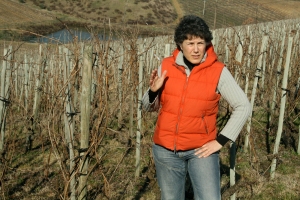Day One in Romagna
FAENZA, Italy – The second thing Cristina Geminiani does, after shaking hands all around while needlessly apologizing for her excellent English, is issue the 10 or so of us visiting journalists a pair of plastic covers for our shoes.
“It’s nice today but it’s been rainy,” said Cristina, winemaker and grandaughter of Vincenzo Geminiani, the founder of Fattoria Zerbina, where we are visiting today (Feb. 19). “You’ll see you need these to keep your shoes clean when we walk in the vines.”
The soils of this hilly country only 25 miles or so from the Adriatic Sea are mostly clay, underlaid with a chalk or limestone shelf.
“It’s good for the vines because it holds the moisture,” said Geminiani, pointing out the 80 steep hectares of vines on which she raises (mostly) sangiovese, albana (the white grape of the Emilia-Romagna area) and small amounts of trebbiano, cabernet sauvignon, merlot and riesling. “The soil holds the moisture for the vines, even in the hottest times.”

Winemaker Cristina Geminiani of Fattoria Zerbina talks about growing and making world-class Sangiovese di Romagna. The name "Zerbina" in the local Faenza dialect refers to the breeze off the Adriatic Sea that moderates temperatures year-round.
Which is good, since the Consorzio Vini di Romagna (the local winemakers organization) must give winemakers special permission to irrigate.
“We do it maybe one year in 10, and then only up on the top, where the soils are bit different,” Cristina said. “And then it’s only the albana and it’s not to make the bunches larger but to retain the acidity.”
Local lore says sangiovese was first discovered by the Capuchin friars in Romagna, on Monte Giove (Mount Jupiter) near Rimini, a few kilometers to the east of where we were standing.
“The history of sangiovese goes back 500 years but it’s been cultured only since 200 years ago,” Cristina told us.
This area is trying hard to increase its exposure and its reputation for making high-quality sangiovese, which is why the Convito di Romagna and the Consorzio Vini di Romagna sponsored this trip for us.
Think of sangiovese and what comes to mind for most of us is Tuscany and Chianti Classico, often considered the gold standard for top-quality sangiovese.
What we’ve heard repeated during our brief time here is “We’re as good as Tuscany,” an argument also heard in the U.S. when wine-growing areas compare themselves to Napa or Sonoma.
That’s not say the winemakers in Romagna want to be another Tuscany, except in acceptance and sales.
Until very recently, we are told, Romagna sangiovese was made fast to drink fast.
“By February it was no good, but by then it had all been drunk,” one winemaker (not Cristina) told us.
But a generation of Romagna winemakers, including Cristina’s grandfather, decided sangiovese had more potential and worked hard to better the local wine, pushing it to unprecedented levels of quality, acceptance and yes, profits.
It took years and in the 1980s the wines started improving, Cristina said.
“The first ‘quality” sangiovese was in the 1980s and my first harvest was in 1985,” said Cristina.
At the time the winery was blending some cabernet, merlot and syrah with all their sangiovese but today the Pietramora Sangiovese di Romagna superiore riserva is 100 percent sangiovese while the IGT wines continue to be blends.
“We phased out the international grapes (for the riserva) and went back to the indigenous sangiovese,” she said.
Indigenous referring to stories of how sangiovese was first discovered in the Romagna region. That Tuscan version is a more-recent offshoot, so the stories go, taking advantage of the sangionvese-friendly conditions in the area about 90 kilometers to the east of Romagna, just over the Appenine Mountains.
Cristina said the 1997 vintage is generally considered a great vintage for the region but her favorite is the 1998.
And the hot year of 2003 holds a special place for her.
“It was very hot but the wines were very beautiful,” Cristina said. “It was a very difficult and challenging year for us but when it’s that difficult and the wines come out so well, you know the winemaker has done a good job.”
We are tasting all her wines Monday during the Vini Ad Arte tasting, along with wines from another 12 or so wineries. The bus taking us to dinner is waiting, so more news later.
(This post was amended to clarify which wines are 100 percent sangiovese.)